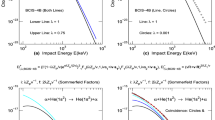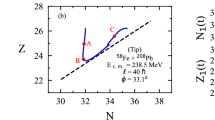Abstract.
Classical Trajectory Monte Carlo method (CTMC) with the modal interaction potential [1] has been used to simulate the differential, total and partial capture cross sections in proton-oxygen atom collisions in the energy range of 0.5–200 keV. An interesting feature of the calculated differential cross sections (DCS) curve below the scattering angle 0.1○ is the presence of oscillations showing asymmetry in angular positions. The oscillations in the partial cross sections are explained in terms of swapping effect. The DCS and total cross sections are found to be in good agreement with the experimental as well as other theoretical results.
Similar content being viewed by others
References
B. Hamre, J.P. Hansen, L. Kocbach, J. Phys. B 32, L127 (1999)
R.E. Johnson, Energetic Charged Particle Interactions with Atmospheres and Surfaces (Springer, Berlin, 1990)
M. Kimura, J.P. Gu, G. Hirsch, R.J. Buenker, Phys. Rev. A 55, 2778 (1997)
J. Rutherford, D.A. Vroom, J. Chem. Phys. 61, 2514 (1974)
C.K. Tan, A.R. Lee, J. Phys. B 14, 2409 (1981)
P.C. Stancil, D.R. Schultz, M. Kimura, J.-P. Gu, G. Hirsch, R.J. Buenker, Astron. Astrophys. Suppl. Ser. 140, 225 (1999)
R.F. Stebbings, A.C.H. Smith, H. Ehrhardt, J. Geophys. Res. 69, 2349 (1964)
B.G. Lindsay, D.R. Sieglaff, D.A. Schafer, C.L. Hakes, K.A. Smith, R.F. Stebbings, Phys. Rev. A 53, 212 (1996)
W.R. Thompson, M.B. Shah, H.B. Gilbody, J. Phys. B 29, 725 (1996)
P.M. Stier, C.F. Barnett, Phys. Rev. 103, 896 (1956)
F.J. de Heer, J. Schutten, H. Moustafa, Physica 32, 1766 (1966)
B. Van Zyl, T.M. Stephen, in Abstracts of Contributed papers of the seventeenth International Conference on the Physics of Electronic and Atomic Collisions, Brisbane 1991, edited by I.E. McCarthy, M.C. Standage (Hilger, Bristol, 1992)
I.D. Williams, J. Geddes, H.B. Gilbody, J. Phys. B 17, 1547 (1984)
A.N. Perumal, D.N. Tripathi, J. Phys. Soc. Jpn 66, 3783 (1997)
A.N. Perumal, D.N. Tripathi, Nucl. Instrum. Meth. B 143, 429 (1998)
A.N. Perumal, D.N. Tripathi, Phys. Rev. A 64, 042709 (2001)
R.E. Olson, A. Salop, Phys. Rev. A 16, 531 (1977)
G. Peach, S.L. Willis, M.R.C. McDowell, J. Phys. B 18, 3921 (1985)
J. Pascale, R.E. Olson, C.O. Reinhold, Phys. Rev. A 42, 5305 (1990)
M.K. Pandey, R.K. Dubey, D.N. Tripathi, Eur. Phys. J. D 41, 275 (2007)
R. Abrines, I.C. Percival, Proc. Phys. Soc. 88, 861 (1966)
A.N. Perumal, D.N. Tripathi, J. Phys. Soc. Jpn 66, 3738 (1997)
R.E. Olson, Phys. Rev. A 27, 1871 (1983)
R.L. Becker, A.D. Mackellar, J. Phys. B: At. Mol. Phys. 17, 3913 (1984)
K.B. MacAdam, J.C. Day, J.C. Aguilar, D.M. Homan, A.D. MacKellar, M.J. Cavagnero, Phys. Rev. Lett. 75, 1723 (1995)
A.N. Perumal, D.N. Tripathi, Eur. Phys. J. D 8, 169 (2000)
D.M. Homan, K.B. MacAdam, M.J. Cavagnero, Phys. Rev. A. 57, R13 (1998)
D.R. Schultz, C.O. Reinhold, P.S. Krstic, Phys. Rev. Lett. 78, 2720 (1997)
S. Yu, Ovchinnikov, E.A. Solov'ev, Sov. Phys. JETP 63, 538 (1986)
Author information
Authors and Affiliations
Corresponding author
Rights and permissions
About this article
Cite this article
Pandey, M., Dubey, R. & Tripathi, D. Charge transfer in keV proton collision with atomic oxygen: Differential and total cross sections. Eur. Phys. J. D 45, 273–277 (2007). https://doi.org/10.1140/epjd/e2007-00262-x
Received:
Published:
Issue Date:
DOI: https://doi.org/10.1140/epjd/e2007-00262-x




